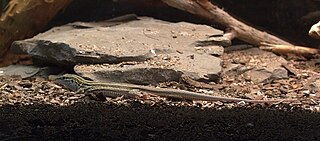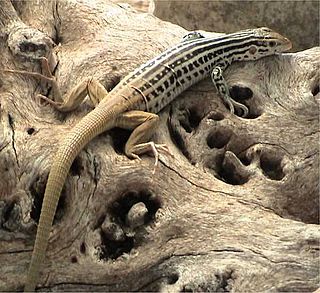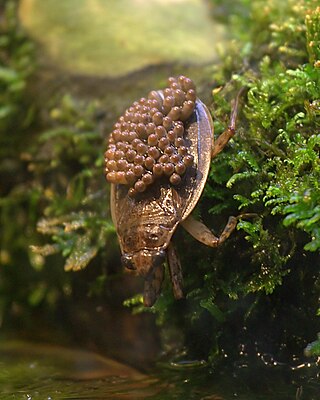
The greater earless lizard is the only species in the monotypic genus Cophosaurus. It is closely related to the smaller, lesser earless lizards and other species in the genus Holbrookia, and in fact was placed in that genus and referred to Holbrookia texana from 1852 into the 1970s. Earless lizards lack external ear openings, an adaptation to burrowing in the sand, as are the recessed lower jaw and flared upper labial scales. Greater earless lizards are sexually dimorphic, males grow larger and are more colorful than females, exhibiting pink and green colors that are particularly bright in the breeding season. Two bold black bars mark the lateral region of males but are greatly reduced and vague, or occasionally entirely absent in females.

Grasshoppers are a group of insects belonging to the suborder Caelifera. They are among what is possibly the most ancient living group of chewing herbivorous insects, dating back to the early Triassic around 250 million years ago.

The desert horned lizard is a species of phrynosomatid lizard native to western North America. They are often referred to as "horny toads", although they are not toads, but lizards.

The western whiptail is a species of lizard in the family Teiidae. The species is found throughout most of the southwestern United States and northern Mexico. Most of its populations appear stable, and it is not listed as endangered in any of the states comprising its range. It lives in a wide variety of habitats, including deserts and semiarid shrubland, usually in areas with sparse vegetation; it also may be found in woodland, open dry forest, and riparian growth. It lives in burrows. Major differences between this species and the checkered whiptail include the lack of enlarged scales anterior to the gular fold and the presence of enlarged postantebrachial scales. It was previously known as Cnemidophorus tigris, until phylogenetic analyses concluded that the genus Cnemidophorus was polyphyletic. Since it does not migrate, a number of forms have developed in different regions, several of which have been given subspecific names – for example the California whiptail, Aspidoscelis tigris munda.

The desert grassland whiptail lizard is an all-female species of reptiles in North America. It was formerly placed in the genus Cnemidophorus. A common predator of the whiptail lizard is the leopard lizard that preys on A. uniparens by using ambush and stalk hunting tactics. These reptiles reproduce by parthenogenesis. In this process, eggs undergo a chromosome doubling after meiosis, developing into lizards without being fertilized. However, ovulation is enhanced by female-female courtship and mating (pseudo-copulation) rituals that resemble the behavior of closely related species that reproduce sexually.

The western diamondback rattlesnake or Texas diamond-back is a rattlesnake species and member of the viper family, found in the southwestern United States and Mexico. Like all other rattlesnakes and all other vipers, it is venomous. It is likely responsible for the majority of snakebite fatalities in northern Mexico and the greatest number of snakebites in the U.S. No subspecies are currently recognized.

The New Mexico whiptail is a female-only species of lizard found in New Mexico and Arizona in the southwestern United States, and in Chihuahua in northern Mexico. It is the official state reptile of New Mexico. It is one of many lizard species known to be parthenogenetic. Individuals of the species can be created either through the hybridization of the little striped whiptail and the western whiptail, or through the parthenogenetic reproduction of an adult New Mexico whiptail.

The six-lined racerunner is a species of lizard native to the United States and Mexico.

The little striped whiptail is a species of lizard found in the southwestern United States and in northern Mexico. A significant amount of research was done on the species during the mid-1990s, with several new subspecies being added, many of which some sources consider to be distinct enough to warrant full species status, and the research is ongoing. It is called little to distinguish it from many other species known as striped whiptails and to indicate that it is the smallest of those species.

Romalea is a genus of grasshoppers native to the Southeastern and South-central United States. As traditionally defined, it contains a single species, Romalea microptera, known commonly as the Georgia Thumper,eastern lubber grasshopper, Florida lubber, or Florida lubber grasshopper, although some recent authorities regard Taeniopoda as a junior synonym, in which case there are about a dozen Romalea species in southern United States, Mexico and Central America.

Brachygastra mellifica, commonly known as the Mexican honey wasp, is a neotropical social wasp. It can be found in North America. B. mellifica is one of few wasp species that produces honey. It is also considered a delicacy in some cultures in Mexico. This wasp species is of use to humans because it can be used to control pest species and to pollinate avocados.

Saga pedo is a species of wingless bush cricket from the southern half of Europe and western and central Asia. This brown or green bush cricket typically has a total length, from the head to the tip of the ovipositor, of up to 10.5 cm (4.1 in), but exceptionally it may reach 12 cm (4.7 in), which makes it one of the largest European insects and one of the world's largest Orthoptera. The head-and-body alone typically is 5–7 cm (2.0–2.8 in) long in adults, but may reach up to 7.8 cm (3.1 in).

Taeniopoda eques, the western horse lubber grasshopper, is a relatively large grasshopper species of the family Romaleidae found in arid and semi-arid parts of southwestern United States to central and southwestern Mexico. Most populations are identifiable by their shiny black bodies with contrasting yellow markings, but some adults are mostly yellowish, orangish or greenish. The species is unique in using its black coloration to thermoregulate and in being chemically defended. The aposematic coloration warns vertebrate predators of its unpalatability and allows the grasshopper to roost conspicuously upon shrubs.

Schistocerca americana is a species of grasshopper in the family Acrididae known commonly as the American grasshopper and American bird grasshopper. It is native to North America, where it occurs in the eastern United States, Mexico, and the Bahamas. Occasional, localized outbreaks of this grasshopper occur, and it is often referred to as a locust, though it lacks the true swarming form of its congener, the desert locust.
Cornops aquaticum is a semiaquatic species of grasshopper native to the Neotropics, from southern Mexico south to central Argentina and Uruguay. It feeds and breeds exclusively on members of the aquatic plant family Pontederiaceae, especially water hyacinth, and is being investigated as a possible biological pest control agent for the water hyacinth in countries where that plant is invasive.

Chortophaga viridifasciata, the green-striped grasshopper, is a species of band-winged grasshopper in the family Acrididae.

Abedus herberti, the toe biter or ferocious water bug, is a species of giant water bug in the family Belostomatidae. It is native to streams, especially in highlands, in Arizona, New Mexico and Utah in the United States and in northwestern Mexico. Adults are typically 2 to 4 cm (0.8–1.6 in) long. The species is flightless, but may move overland between water sources. It will bite in self-defense, which is painful but not dangerous.
Aeoloplides tenuipennis, known generally as the narrow-winged saltbush grasshopper or narrow-winged bush grasshopper, is a species of spur-throated grasshopper in the family Acrididae. It is commonly found in eastern California, Arizona and southwestern New Mexico north through Utah and southern Nevada to southern Idaho.

The giant mesquite bug is an insect of the order Hemiptera, or the "true bugs". As a member of the family Coreidae, it is a leaf-footed bug. As the common name implies, it is a large bug that feeds on mesquite trees of the American Southwest and Northwestern Mexico.

Eyprepocnemis plorans, the lamenting grasshopper, is a species of insect in the family Acrididae. It is the type species of the genus Eyprepocnemis, and is found in Africa, parts of the Middle East, and southern Europe. It typically inhabits wetlands and other moist habitats.

















